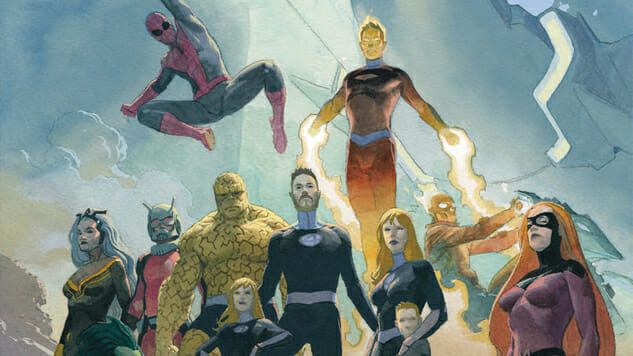All 20 Members of the Fantastic Four, Ranked
Yes, There Are More Than Four of Them
Main Art by Esad Ribic
After years roaming the publishing wilderness, the Fantastic Four are finally back at the center of the Marvel Universe. Everybody should know the core four members of Marvel’s First Family: Reed Richards, a.k.a. Mr. Fantastic, who can stretch and flatten himself out; his wife, Sue Richards, the Invisible Woman, who can turn invisible and create force fields; her brother, Johnny Storm, who, as the Human Torch, can unsurprisingly turn himself into a living creature of fire; and Reed’s roughhewn best friend, Ben Grimm, who’s twisted into a massive but lovable rock creature known as The Thing. These four have been the main members of the team since Jack Kirby and Stan Lee’s Fantastic Four #1 kicked off the Silver Age rebirth of Marvel’s superheroes in 1961. They haven’t been Marvel’s most popular or best-selling characters in decades, but they’ll always hold a special place within the Marvel Universe and the hearts of its fans, especially in light of the sad news that Lee has passed away.
Of course there have been way more than four members of the Fantastic Four. Even if you don’t count versions from the future or from alternate universes, the comics have seen 20 members of the Fantastic Four over the last 57 years. Some of them have long-running relationships with the original members, while others were short blips on the radar when a founding member had to take some time off. Marvel’s recent relaunch of the Fantastic Four comic features a history-spanning story written by the living Marvel encyclopedia Dan Slott, so it seemed like a great time for Paste to dig into the team’s history and decide once and for all where every member of the team would fall in an objective ranking. Or maybe an incredibly subjective ranking. Whatever. We’re not weighing them based on how they are as characters, overall, but specifically in relation to their connection to the Fantastic Four.
One final note before we jump in: you’ll eventually notice that we didn’t include either of Reed and Sue’s children. Franklin and Valeria Richards have long, rich histories within the comic (Franklin has been around for over 50 years, despite still looking like he’s 10 today). They’ve never been true active members, though, no matter how many times they’ve helped their family save the world. It’s a tough call, but we left them off for that reason. If you absolutely must know where they’d rank, though, we’d put ‘em pretty high, as, like the Fantastic Four itself, family is a huge priority here at Paste.
![]()

Fantastic Four #349 Art by Al Migrom
20. Wolverine
As part of the New Fantastic Four, Wolverine’s short stint was basically a metacommentary on the sales gimmick of popular characters making cameos in less popular comics that they have no connection to. Of the four characters who made up the New FF, Wolverine makes the least sense outside of his commercial appeal. His murder-first approach is at odds with the shiny optimism of the comic, and no matter how many times Chris Claremont sent him to the Shi’ar Empire, Wolverine’s always thoroughly out of place in the kind of cosmos-spanning sci-fi epics that Fantastic Four is known for.
![]()

Fantastic Four #374 Art by Paul Ryan
19. Ghost Rider
Another New Fantastic Four member, the Danny Ketch version of Ghost Rider makes just as little sense in the Fantastic Four. The only reason he’s one number higher than Logan is because his demonic origin and unearthly appearance are marginally more in line with the comics’ outsized scope than a surly Canadian in a pointy mask. Also, Gary Friedrich (or maybe Mike Ploog) was right: flaming skulls really do just look cool.
![]()

Fantastic Four #348 Art by Arthur Adams
-

-

-

-

-

-

-

-

-

-

-

-

-

-

-

-

-

-

-

-

-

-

-

-

-

-

-

-

-

-

-

-

-

-

-

-

-

-

-

-
























































